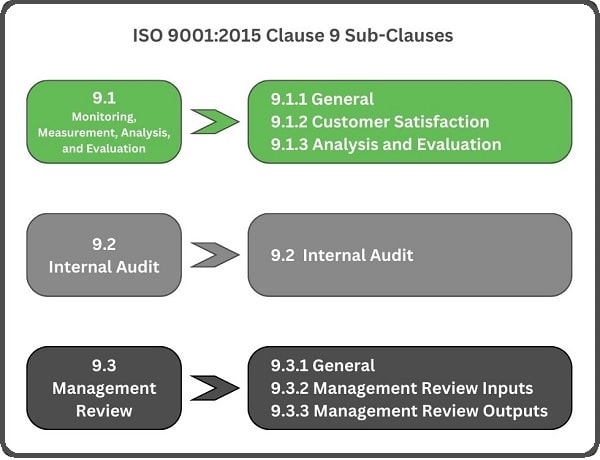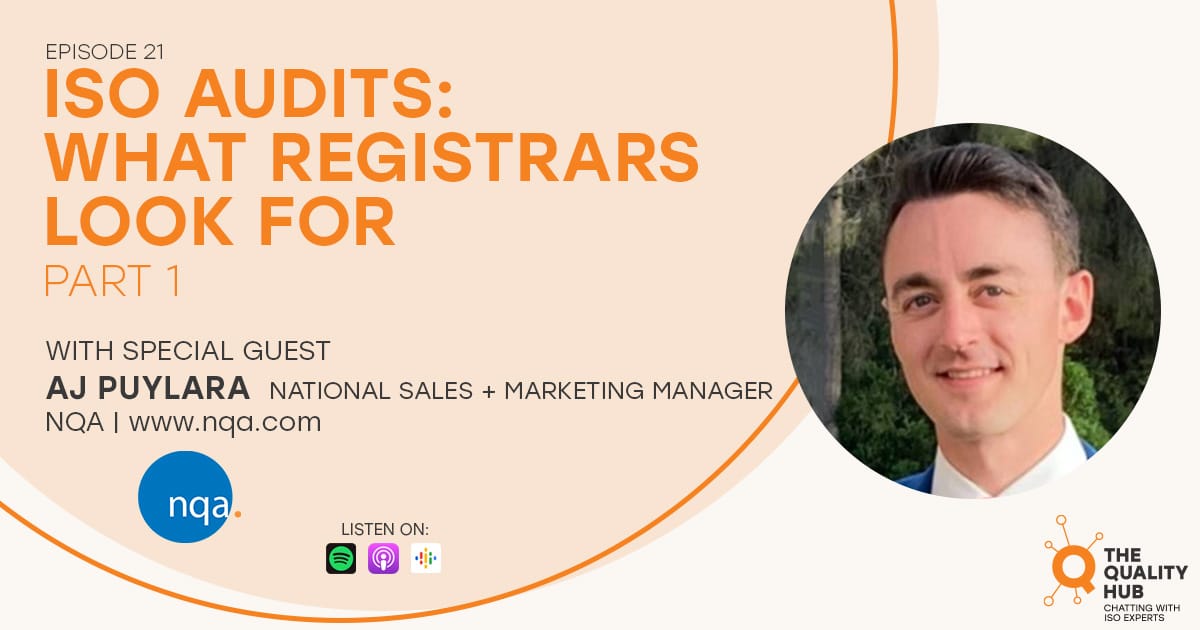ISO 9001:2015 Clause 9.1
What is ISO 9001:2015 Clause 9.1?
Clause 9.1 of ISO 9001:2015 addresses monitoring, measurement, analysis, and evaluation. This clause is essential for ensuring that organizations establish and implement processes to monitor and measure various aspects of their quality management system (QMS) to achieve continual improvement.
Key points outlined in Clause 9.1 include:
Performance Evaluation:
Establish processes to monitor, measure, analyze, and evaluate the QMS’s performance and effectiveness. This involves determining what needs to be measured, how it will be measured, and setting criteria for evaluation.
Customer Satisfaction:
Monitor and evaluate customer satisfaction by using appropriate methods such as surveys, feedback, complaints, and reviews.
Analysis of Data:
Analyze relevant data and information collected from monitoring and measurement activities to assess the performance of processes, products, and services.
Get a Free Quote
Internal Audits:
Conduct internal audits at planned intervals to ensure the QMS’s conformity, effectiveness, and identification of areas for improvement.
Management Review:
Undertake regular management reviews to assess the QMS’s suitability, adequacy, effectiveness, and alignment with the organization’s strategic direction.
Continual Improvement:
Use the results of monitoring, measurement, analysis, and evaluation to drive continual improvement efforts within the organization.
Clause 9.1 emphasizes the importance of systematically collecting data, analyzing information, and evaluating the performance of the QMS to make informed decisions and drive improvements. It enables organizations to track their progress, identify areas for enhancement, and ensure the QMS effectively supports the organization’s objectives and customer satisfaction.
How do you comply with Clause 9.1?
Compliance with Clause 9.1 of ISO 9001:2015, focusing on monitoring, measurement, analysis, and evaluation within a quality management system (QMS), involves several steps and practices:
Establish Relevant Metrics and Indicators:
Define key performance indicators (KPIs), metrics, and targets that align with the organization’s objectives and customer requirements. These indicators should cover various aspects of the QMS, such as product/service quality, process efficiency, customer satisfaction, etc.
Implement Monitoring and Measurement Processes:
Develop and implement processes to collect data and information related to the established metrics. This may involve regular data collection through methods like inspections, surveys, audits, and performance assessments.
Analyze Data and Information:
Analyze the collected data and information to evaluate the performance of the QMS. Use statistical analysis, trend analysis, or other appropriate methods to derive meaningful insights from the data.
Evaluate Customer Satisfaction:
Collect and assess customer feedback, complaints, and satisfaction surveys to understand customer perceptions and satisfaction levels. Use this information to drive improvements and address any areas of concern.
Conduct Internal Audits:
Perform internal audits at planned intervals to review the QMS’s conformity and effectiveness. These audits help identify non-conformities, and areas for improvement, and assess the QMS’s compliance with ISO 9001 requirements.
Management Reviews:
Conduct regular management reviews where top management evaluates the QMS’s performance, adequacy, and alignment with organizational goals. Use these reviews to make strategic decisions and allocate resources for continual improvement.
Continual Improvement:
Use the outcomes of data analysis, audits, and reviews to identify opportunities for improvement. Implement corrective actions, preventive measures, and initiatives to enhance the QMS’s effectiveness and efficiency continuously.
Documentation and Records:
Maintain accurate and comprehensive records of monitoring, measurement, analysis, and evaluation activities. This documentation serves as evidence of compliance and provides a basis for decision-making and improvement initiatives.
Training and Awareness:
Ensure that relevant personnel are trained and aware of their roles in the monitoring, measurement, and evaluation processes within the QMS. Effective training helps in accurate data collection and analysis.
By systematically following these steps and integrating robust monitoring, measurement, analysis, and evaluation processes into the QMS, organizations can comply with Clause 9.1 of ISO 9001:2015. This compliance fosters continual improvement, enhances performance, and supports the organization in achieving its objectives.

What is the History of Clause 9.1?
The history of Clause 9.1 in the ISO 9001 standard, which focuses on monitoring, measurement, analysis, and evaluation within a quality management system (QMS), has evolved through various revisions:
ISO 9001:1987:
The initial version of ISO 9001 didn’t have the same structured clauses as later versions. However, the concept of monitoring and measuring quality was embedded within various sections related to quality control and assurance.
ISO 9001:1994:
This version introduced a more structured approach to quality management systems. While there wasn’t a specific clause dedicated to monitoring and measurement, requirements related to inspection, testing, and corrective actions indirectly addressed these aspects.
ISO 9001:2000:
The 2000 revision emphasized a process-based approach. Though there was no standalone clause for monitoring, measurement, analysis, and evaluation, the focus on process control and improvement laid the groundwork for a more structured assessment of QMS performance.
ISO 9001:2008:
This version continued emphasizing the importance of process management. However, there were no significant changes specifically addressing monitoring and measurement.
ISO 9001:2015:
The current version introduced Clause 9.1, explicitly focusing on monitoring, measurement, analysis, and evaluation. This clause emphasizes the systematic collection of data, analysis of information, and continual improvement based on these evaluations.
Over time, the ISO 9001 standard evolved to explicitly recognize the significance of monitoring, measurement, analysis, and evaluation as integral components of a QMS. The inclusion of Clause 9.1 in the 2015 version marked a more structured and detailed approach to assessing and improving the effectiveness of a QMS.
This evolution reflects a deeper understanding of the importance of data-driven decision-making and continual improvement in achieving organizational objectives and enhancing customer satisfaction.
Helpful Resources: ISO Audits – What Registrars Look For Part 1
In this episode of “The Quality Hub: Chatting with ISO Experts,” host Xavier Francis interviews AJ Puylara, National Sales and Marketing Manager at NQA, a global certification body. AJ shares his experience in the ISO industry and discusses the ISO certification process. He highlights the steps involved, including engaging with a third-party ISO consultant or registrar and conducting a gap assessment. Listen Now
Consulting Support for ISO 9001
Every year, we help hundreds of small businesses achieve ISO 9001 certification. Support for ISO 9001 is available through any of our Consulting Programs As an American business with a story like yours, we know that time is valuable. Our expert consultants are here to take on the difficult, technical aspects of certification so you can focus on your business. They’ll work with you every step of the way until you’re successfully certified. Interested? Get a Free Quote.
In many industries, ISO 9001 has become a supply-chain requirement. When landing a big contract, ISO 9001 certification could make all the difference.

About Core Business Solutions
"Core Business Solutions was started by my brother, Mike Dawson, and myself, true entrepreneurs at heart looking for a better way to make a living and help small businesses improve the quality of the products and services they provide.
The bottom line: we are real people that have developed a team to come along side you to help you grow and succeed."
-- Scott Dawson, President
Related Standards
We provide consulting support for various other standards, as well as support for companies seeking multiple certifications through an Integrated Management System.
AS9100
Aerospace Manufacturers
AS9120
Aerospace Distributors
ISO 14001
Environmental Management Systems
ISO 27001
Information Security Management Systems
ISO 20000-1
Service Management Systems
ISO 45001
OH&S Management Systems
ISO 13485
Medical Device Manufacturers
AS9100
AS9120
ISO 14001
ISO
20000-1
ISO 27001
ISO 45001
ISO 13485
Equip Your Business to Meet ISO 9001 With CORE
At Core Business Solutions, we’re here to equip your company for success in meeting ISO 9001 requirements. We’ve helped hundreds of small businesses grow and deliver the best solutions to their clients. We provide ISO training services, consulting help, and compliance software and to help you get certified and stay certified. We focus on optimizing your processes and helping you implement an ISO-compliant QMS. When you partner with us, you’ll get the tools and help you need for success. For more information on the ISO 9001:2015 standard, please visit our articles page. You can also call our consulting office at 866-354-0300.
Do you want to update your existing ISO 9001 QMS System or refresh it?
We provide consulting services to assist you in your ISO 9001 Quality Management System refresh. We listen, conduct a gap analysis, update your Quality Policy and any necessary documentation or procedures, find areas of waste or improvement, simplify and automate. And we do it fast. Core offers firm, fixed pricing. Download our information sheet today to learn more or call us at 866-354-0300 Extension 2.

